1942 |
Arcade Original: | Title
(Released) | Comments |
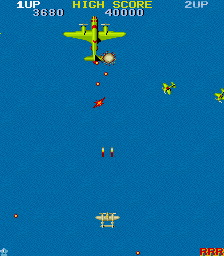 | 1942
(1984) | The arcade classic. A shoot-em-up with you controlling a WWII plane, and has you combatting various sized enemy planes. |
Clones: | Coco Title | Comments |
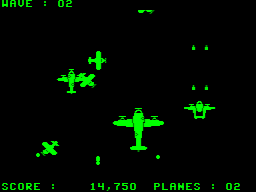 | Fighter Pilot
(1985) | A fairly good clone, although it is missing the bonus shapes, and doesn't allow you to 'flip' you plane over as a dodging tactic. |
Ace |
Arcade Original: | Title
(Released) | Comments |
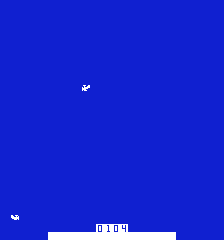 | Ace
(1976) | An old arcade game from the 1970's, this simple game had two players flying around trying to shoot each out of the sky. |
Clones: | Coco Title | Comments |
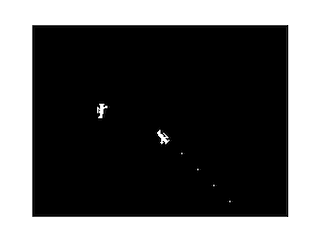 | Dogfight
(1987) | The same as the arcade game, requiring 2 players. This was one of Craig Stewart's first ML games, and was originally published in the April 1987 issue of Australian Coco magazine. |
Amidar |
Arcade Original: | Title
(Released) | Comments |
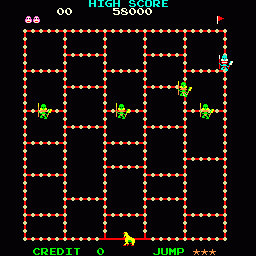 | Amidar
(1981) | The arcade classic, with some gameplay similarities to Qix, in which you have to fill in (paint) the screen by walking around a complete box. Unlike Qix, though, you have set paths that you have to follow. |
Clones: | Coco Title | Comments |
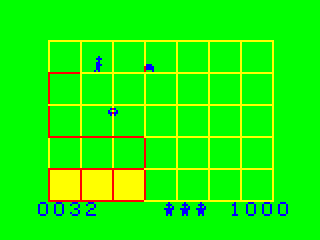 | Cuthbert Goes Walkabout
(1982-1983?) | An fairly close clone, but with fixed box sizes & fairly low-resolution graphics (128x96x4). Originally released on the Dragon 32/64 (an improved Coco 1 clone) in England. |
Arkanoid |
Arcade Original: | Title
(Released) | Comments |
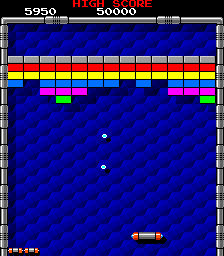 | Arkanoid
(1986) | The massively successful successor to Breakout style games, it added full color graphics, powerups (including lasers), aliens to shoot, and a lot more. Popular enough to spawn it's own sequels, and even had an official port to the Coco (see the Officially Licensed game index. |
Clones: | Coco Title | Comments |
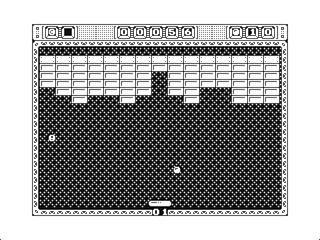 | Balldozer
(1988) | A fairly close clone, missing the aliens but actually having some additional powerups compared to the arcade and designed for black and white (256x192) screens. Originally released on the Dragon 32/64 (an improved Coco 1 clone) in England. |
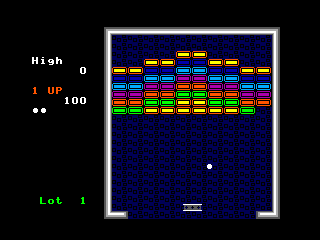 | Bash
(1989) | A slightly simplified version of official arcade adapation for the Coco by the same author - Steve Bjork. Featuring only 20 levels, no aliens coming out and no lasers (although it does have most of the other powerups), it is a bit of a simpler game than the official one, but was still a "fat binary" that supported both the Coco 1/2 and the 3 with their own graphics. Coco 3 version pictured. |
Asteroids |
Arcade Original: | Title
(Released) | Comments |
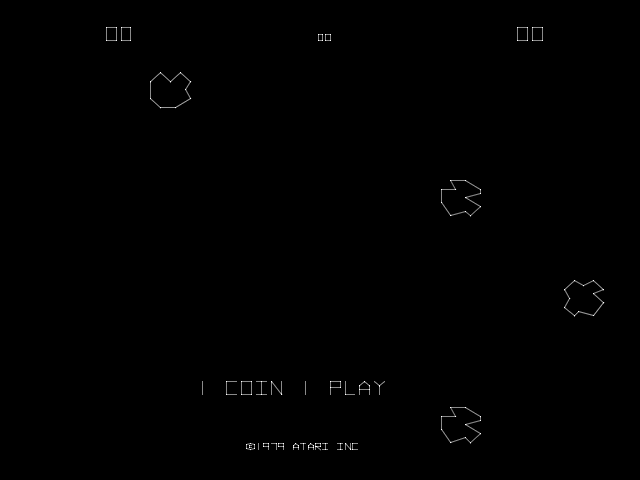 | Asteroids
(1979) | One of Atari's biggest hits. Blow up asteroids and saucers while trying not to be killed/crushed by them. |
Clones: | Coco Title | Comments |
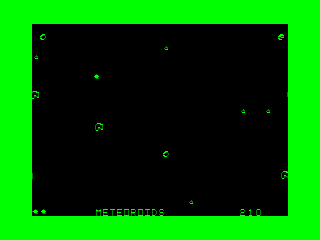 | Color Meteroids (later renamed to Microbes (see below)
(1981) | Quite close to the arcade game (except no real vector graphics, obviously), Color Meteoroids used the Green/black palette, and took two joysticks to control - one to move the ship, and one to move the gun turret (different than the arcade, where the front of your ship always is the gun turret). |
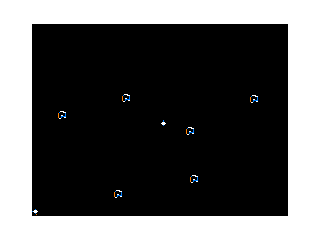 | Microbes (originally Color Meteroids)
(1981/1982) | When Tandy licensed this game from Spectral to put on a cartridge (I believe the first game Spectral sold through Tandy), they changed the color set to black and white, more closely mimicking the original arcade game. |
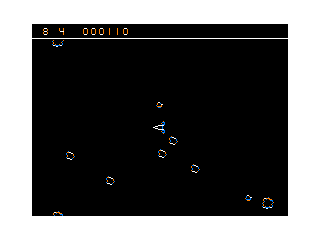 | Star Blaster
(1981) | This game goes a little towards the Asteroids Deluxe arcade game, but not quite enough to be considered a clone of it. Featuring user selectable keyboard or joystick controls, it has the shields from Asteroids Deluxe, but not the snowflake ships. My favourite version of Asteroids on the Coco. |
Astro Fighter |
Arcade Original: | Title
(Released) | Comments |
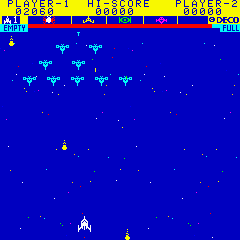 | Astro Fighter
(1980) | The arcade classic, which allowed limited vertical as well as horizontal movement of your ship. |
Clones: | Coco Title | Comments |
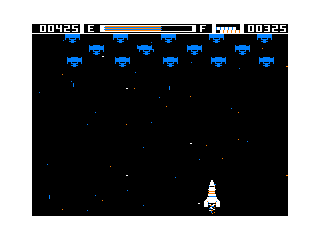 | Astro-Blast
(1982) | An almost exact clone, only missing one of the 5 original waves. The refueling sequence looks a little different as well, but everything down to the comets is in this version. |
Avalanche (more famous clone is Kaboom! by Activision) |
Arcade Original: | Title
(Released) | Comments |
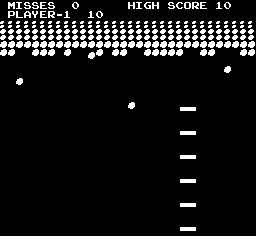 | Avalanche
(1978) | The game that the Atari 2600's Kaboom was based on. |
Clones: | Coco Title | Comments |
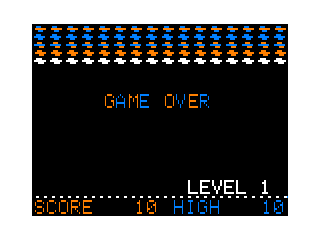 | Popcorn
(late 1981) | The closest clone, appearance wise, to the black and white arcade original from 1978. Also, Steve Bjork's first Coco game that I know of. |
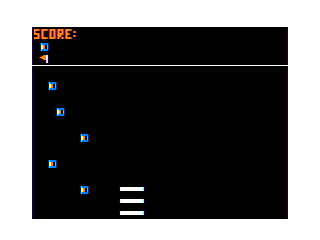 | Catch 'Em
(1982) | Game play more based on the Kaboom! version, but with no "Mad Bomber" at the top. That there are multiple waves of different objects to catch as you progress is the other major difference. |
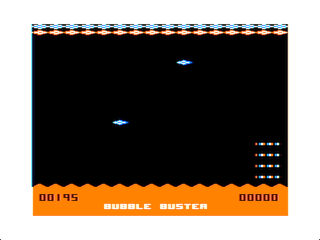 | Bubble Buster
(July 1984) | A very close clone to avalanche (and Popcorn) except in full color and higher resolution grapes. It was from T&D Software Issue #25, the Coco's longest running tape magnazine, and this is a well done version was very affordable. |
Derivative
Games: | Coco Title | Comments |
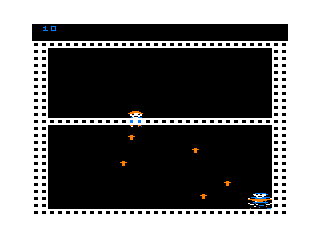 | Able Builders
(1986) | A clone with a twist - instead of having multiple paddles to catch with (and losing them as you miss objects), you just have one... but the height from which they drop changes depending on how well you do (the girder goes up if you do really well, or down if you are not). |
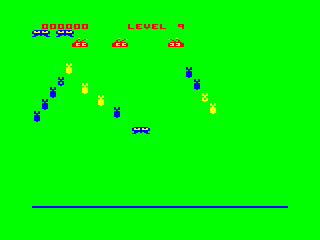 | Starship Chameleon
(1982) | Ken Kalish's take on Avalanche actually extended the game significiantly, adding some indestructable bombs that you have to avoid catching, and dropping two different kinds of bombs that you do catch; but you have to be the same color to catch them. |
Bagman |
Arcade Original: | Title
(Released) | Comments |
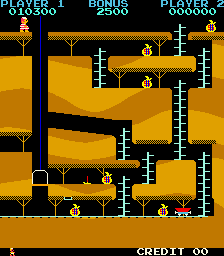 | Bagman
(1982) | Steal moneybags across 3 connected screens. |
Clones: | Coco Title | Comments |
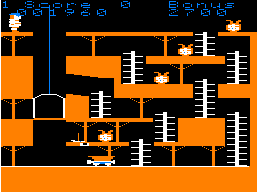 | Bagitman
(1983) | An almost exact clone, basically only missing the music. |
Berzerk |
Arcade Original: | Title
(Released) | Comments |
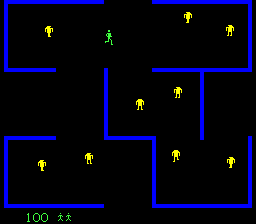 | Berzerk
(1980) | The first talking arcade game. |
Clones: | Coco Title | Comments |
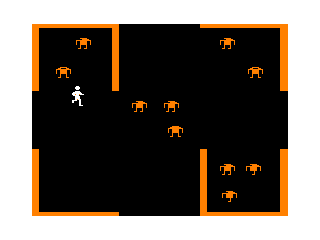 | Berserk (later called Haywire)
(1981) | The closest clone to the arcade. The fact that the original 1981 title was so close to the arcade caused it be renamed in late 1982. No speech, but the closest graphics and gameplay to the original arcade game. |
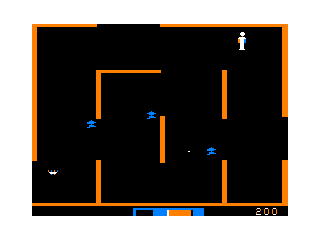 | Android Attack (originally Robot Battle)
(1981/1982) | While the 32K version did have speech like the arcade, the actual gameplay is somewhat different. You can duck and jump (to try and avoid shots), and you have to collect treasures. Also, when you kill a robot, it's debris is left behind; if the debris stays on screen for a certain length of time, it turns into a ghost that, while you can kill it, it can travel through walls (similiar to the Evil Otto character from the original arcade version). |
 | Monster Maze
(1983) | Radio Shack's clone of Berzerk. Like Android Attack, this version diverges from the arcade in several aspects. First, you get way more lives to start with. Second, you have to gather treasures, and third, you can shoot through walls. This version, in cartridge format, only required a 4K RAM machine to run. |
Boot Hill |
Arcade Original: | Title
(Released) | Comments |
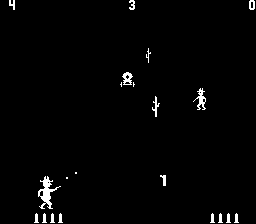 | Boot Hill
(1977) | One of the earlier black and white arcade classics for two players, who played simultaneously shooting each other. |
Clones: | Coco Title | Comments |
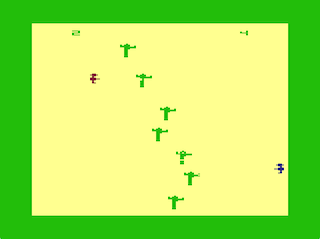 | Shoot-Out
(1983) | A simpler clone that is missing the moving stagecoach, but it still has the scattered cactus that can be shot and damaged. Minimal sound. Like the original, it requires two human players. |
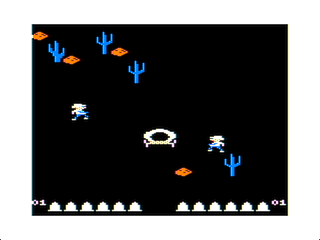 | Gun Fighter
(1985) | A pretty close clone, with enhancements like color graphics, and some 4 voice music interludes. Like the original, it requires two human players. |
Derivative
Games: | Coco Title | Comments |
 | Droid War
(1983) | Also requiring two players simultaneously to shoot each other. Instead of wagons, etc. travelling up the middle to block shots, you have a yellow wall scrolling up that you have to shoot through. An added feature is that the player is guarding 8 droids behind them and the aim of the player is kill all 8. The players can not shoot each other directly; you win by killing the droids. This was originally a type in game for the Dragon 32 in Personal Computer News magazine (September 15-21, 1983) in the UK. |
Bosconian |
Arcade Original: | Title
(Released) | Comments |
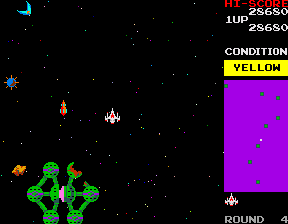 | Bosconian
(1981) | A not hugely popular arcade game at the time, the game combined elements from several popular arcade games - a radar screen like Sinistar or Defender, full 4 way scrolling like Time Pilot, and digitized voices like Berserk. A basic shoot-em-up, with you trying to clear an entire sector of space stations, while avoiding aliens, asteroids and mines. If you take too long, the aliens start really attacking. |
Clones: | Coco Title | Comments |
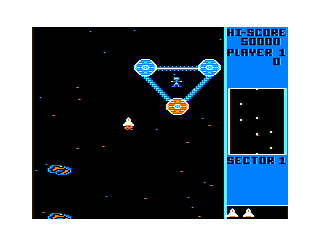 | Draconian
(1984) | A fairly close clone, with the sector maps matching the original, but with a twist and an addition (and no speech): Instead of a frenzied alien attack when your time runs out, you have a huge Dragon fly from the bottom of the sector straight for you. Also, the space stations now contain trapped astronauts, that, after blowing up the stations, you have to rescue them. Multi-voice musical interludes are in the game, and bonus points are rewarded as you dock between each sector. |
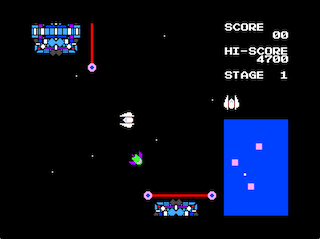 | Ruptus
(2021/2022) | A clone with some differences, created with a cross platform development system in Japan called CATE. The Coco 1/2 and MC-10 versions were released in 2021, while the Coco 3 version came out in 2022. Play is slower and sound and (brief) music is simpler, but it does have versions for dozens of home computers, including the MC-10, Coco 1/2, and Coco 3 (Coco 3 screenshot shown here). |
Boulder Dash |
Arcade Original: | Title
(Released) | Comments |
 | Boulder Dash
(1984) | This arcade game took a different path than most at the time - rather than arcade games getting ported to home computers, this started on home computers and then Exidy ported it to the arcade, based on Atari 8 bit hardware. A spiritual successor to Mr. Do, where one is digging to get diamonds, and dropping boulders on enemies. From that game, Boulder Dash adds being able to push boulders, and greatly enlarging the playfield for each level with 4 way scrolling, permanent walls, etc. |
Clones: | Coco Title | Comments |
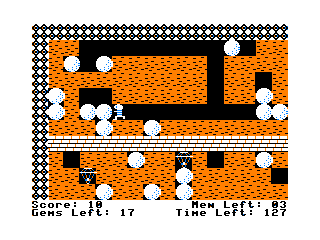 | Bouncing Boulders
(1986) | Very close to the arcade version, this clone required 64K, and tried to make the sprites, etc. look fairly close to the arcade version. |
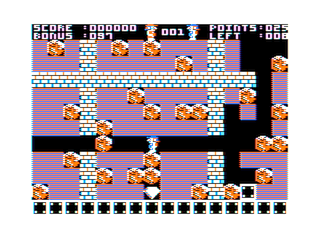 | Stone Raider II
(1986) | This clone was made for both the Dragon 32/64 and Coco 1/2 in the UK, and only required 32K. It has some musical interludes that Bouncing Boulders lacks, and since it was designed for PAL TV systems (which don't support artifact colors) the original UK version was set up for pure 256x192 black and white graphics. A cute change is that the main player sprite bears a striking resemblance to Mario from Donkey King. |
Burgertime |
Arcade Original: | Title
(Released) | Comments |
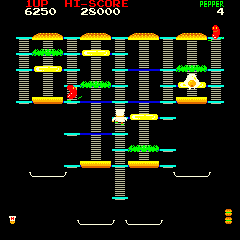 | Burgertime
(1982) | A rather unique concept, in which you (as the cook), try to assemble gigantic burgers, while trying to dodge other types of food that are trying to kill you. By running completely over a burger ingredient, you cause it to fall to the next level, and eventually you get all the pieces together to make a complete burger. You also have limited Pepper spray to scare the pickles, eggs, etc. off. |
Clones: | Coco Title | Comments |
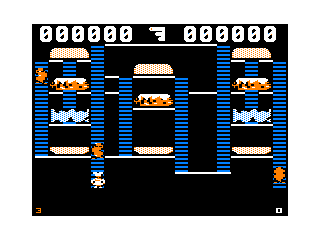 | Lunchtime
(1986) | A close clone of the original arcade version, except (because of the smaller screen) with less complicated platforms to work from. All the gameplay is there, and the shapes (given Coco 1/2 graphics limitations) are pretty close to the arcade. |
Carnival |
Arcade Original: | Title
(Released) | Comments |
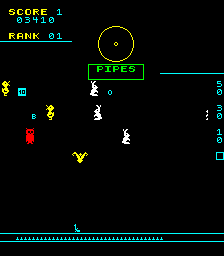 | Carnival
(1980) | A carnival shooting gallery, with various moving targets (and some to get you extra bullets). There is also a bonus stage where you shoot a bear as many times as you can (each time you hit him the bear speeds up and reverses direction, until it runs off the screen). |
Clones: | Coco Title | Comments |
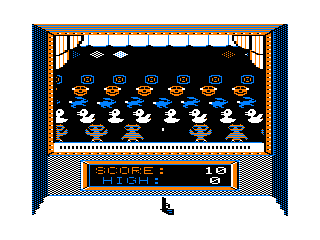 | Shooting Gallery
(1982) | A fairly close clone of the original arcade version, except it's missing the turning target at the top, and the bonus stage involves a large man instead of a bear. Graphics look better than the original arcade version. |
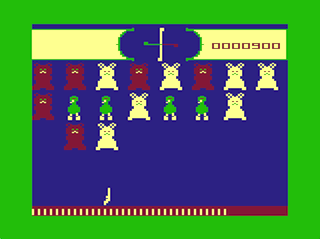 | Shooting Gallery (T&D)
(June 1983) | A lesser clone that is more jerky, but that is because it is written mostly in BASIC with some ML subroutines. Pretty good for a magazine game, but is missing the bear screen. |
Centipede |
Arcade Original: | Title
(Released) | Comments |
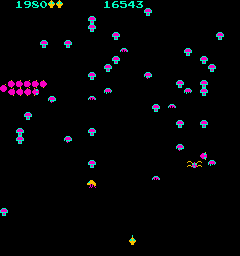 | Centipede
(1980) | The arcade classic, which allowed limited vertical as well as horizontal movement of your ship. |
Clones: | Coco Title | Comments |
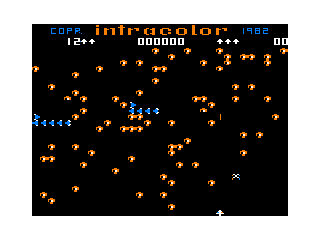 | Colorpede
(1982) | The closest clone, appearance wise, to the arcade original. The mushrooms actually change color each wave, like the arcade, and it includes the scorpion, which some versions did not. Also the first game by Intracolor. |
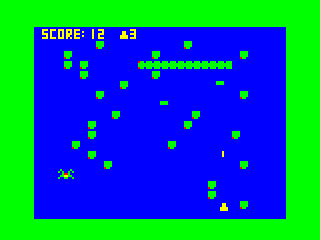 | Caterpillar
(1982) | Also a very close clone, game-play wise, to the arcade (but a lower resolution than Colorpede). Sound is just about non-existant, though. |
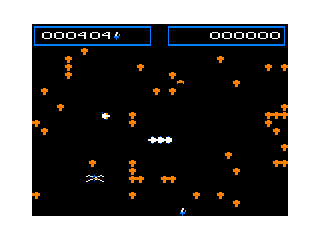 | Color Caterpillar
(1983) | Another very close clone to the original. Better sound than Caterpillar, but the graphics aren't quite as good as Colorpede. A port from Rugby Circle's original TRS-80 Model I/III version. |
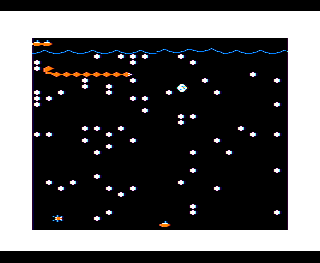 | Slay The Nereis
(1982) | Close clone with the twist that it supposed to take place underwater. |
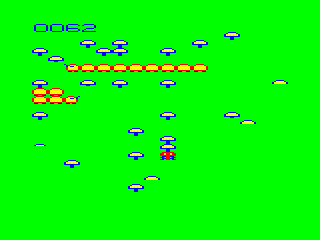 | Katerpillar Attack
(1982) | The earliest Coco clone of of Centipede (early 1982), but lacked the scorpion, and vertical movement was a lot more restrictive than the original (or other clones). The introduction screen was actually more sophisticated than the arcade version, however. |
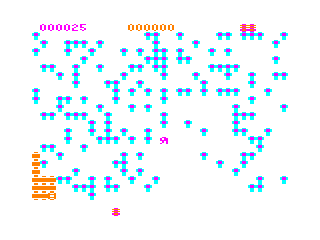 | Megapede
(1983) | Computerware's version of Centipede... fairly close clone, but, like Katerpillar Attack, it is missing the Scorpion. |
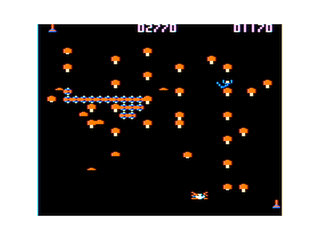 | Wiggle Worm
(Feb 1984) | Included with the February, 1984 of tape magazine's Chromasette, Wiggle Worm was a surprisingly close version to the arcade (including the scorpion). Vertical movement was a tiny bit restrictive, and it was limited to 1 player, but a good clone (especially for the price). |
Circus |
Arcade Original: | Title
(Released) | Comments |
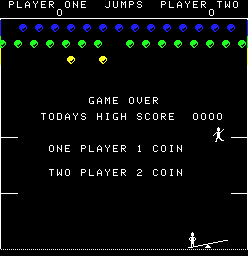 | Circus
(1977) | You have to pop balloons by controlling bouncing people at the bottom of the screen. This game itself was copied in the arcades by a game called Clowns (by a different company) in 1978. It should be noted that the arcade originals are really black and white; the color in the screenshot is from the clear, colored plastic overlays that a lot of the late 1970's/early 1980's games used. |
Clones: | Coco Title | Comments |
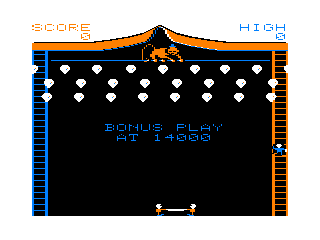 | Clowns & Balloons
(1982) | A close clone of the original arcade version(s), except with real color, and a bit fancier of a background. The other change is that you control the 2 people on the bottom carrying the trampoline, causing the 3rd clown to bounce; the arcade has two clowns alternating jumps on a see-saw type configuration. |
Columns |
Arcade Original: | Title
(Released) | Comments |
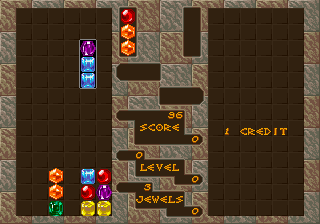 | Columns
(1990) | A game derived from Tetris, except that you don't rotate a shape at 90 degree angles. Instead, you rotate the colored blocks vertically, trying to match 3 or more to eliminate them when they hit the bottom. |
Clones: | Coco Title | Comments |
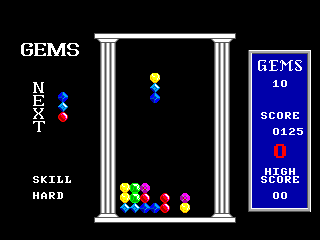 | Gems
(1991) | A fairly close clone, except single player only, and with some flourishes of it's own thrown in (different block sets, and skill levels based on how many unique blocks you can get during a game). The alternate shapes included dice and symbols. |
Contra |
Arcade Original: | Title
(Released) | Comments |
 | Contra
(1987) | This games starts out as a jungle war, but evolves into an alien invasion. It had both side scrolling and pseudo 3-D stages as you progressed.. |
Clones: | Coco Title | Comments |
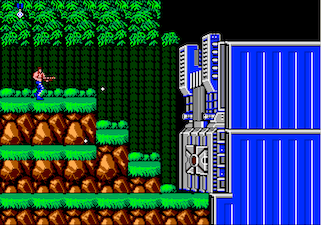 | The Contras
(1993) | While the beginning is very close to the arcade original, starting on stage 2 it becomes itís own unique take on it. There are no 3-D levels, though. Like the arcade original, it did support co-operative multiplayer. The graphics are more based on the Nintendo version, however. |
Crash! |
Arcade Original: | Title
(Released) | Comments |
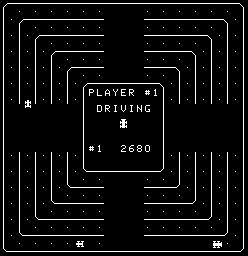 | Crash!
(1979) | A car racing game when you run in the opposite direction as computer controlled players on the same, multi lane track. The object is to avoid the computer players, and collect all the dots to complete a level. This predates Pac Man by a year as a "dot eating game". There another game with identical gameplay, but slightly different graphics, that was released by a different company the same year, called Dodge 'Em. |
Clones: | Coco Title | Comments |
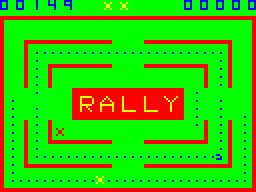 | Rally
(1983) | A close clone, except with coarser graphics, less lanes, and in colour. |
Crystal Castles |
Arcade Original: | Title
(Released) | Comments |
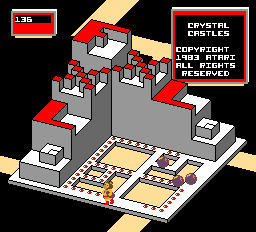 | Crystal Castles
(1983) | A game where you collect the dots while running around on isometric, pseudo 3-D platforms, jumping over your enemies and going through tunnels. From Atari. |
Clones: | Coco Title | Comments |
 | Crystle Castles
(1984) | A pretty darn close clone, although the arcade original changed you to a silhouette when you entered the tunnels; this version showed you in full (which makes it a little confusing, visually). |
Dig Dug |
Arcade Original: | Title
(Released) | Comments |
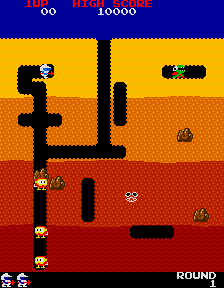 | Dig Dug
(1982) | Dig underground, inflate monsters until they burst. |
Clones: | Coco Title | Comments |
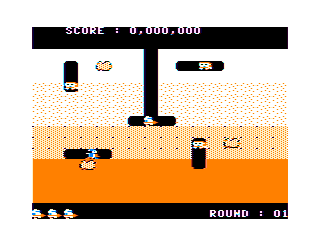 | Pumpman
(1984) | An almost exact clone, basically only missing the music. |
Donkey Kong |
Arcade Original: | Title
(Released) | Comments |
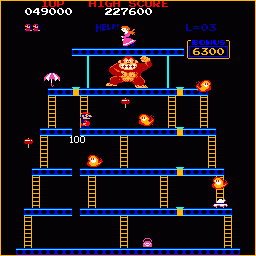 | Donkey Kong
(1981) | The game that Mario originally came from. Features 4 screens and playful intermissions. |
Clones: | Coco Title | Comments |
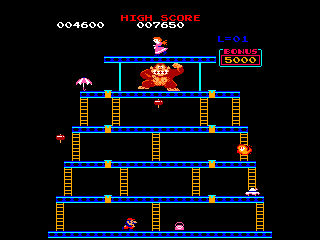 | Donkey Kong
(2007) | The most exact clone of an arcade game ever done on the Coco... because it is actually a direct translation with emulated graphics/sound hardware. This is the arcade game, with all music, intermissions, etc... and proves that the Coco 3 could directly emulate more early 1980 arcade games to a 'T'. |
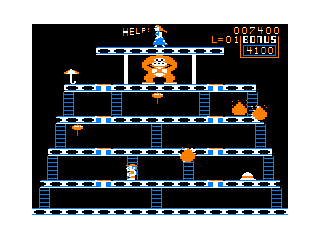 | Donkey King (The King)
(1982) | The most famous clone of all. Features all 4 screens, some of the intermissions, and 4 voice music. |
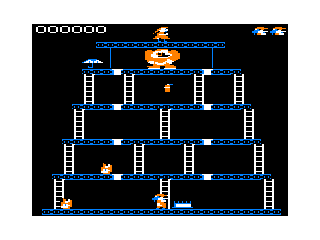 | Dunkey Munkey
(1982) | 2 Screens versus arcade's 4, and the 2nd screen is a combination of the arcade's screens 2 and 3. |
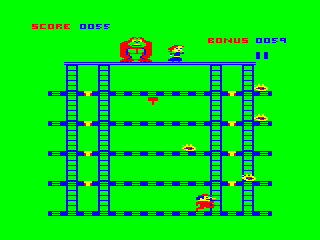 | Monkey Kong
(1983) | First 2 screens from arcade only. The only clone to run in 16K RAM. |
Derivative
Games: | Coco Title | Comments |
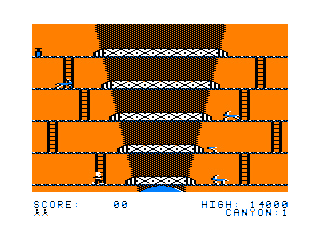 | Canyon Climber
(1982) | Radio Shack/Tandy's loosely based clone, with 3 screens. The first 2 roughly duplicate the first 2 from the arcade; the 3rd is unique. |
Donkey Kong Jr. |
Arcade Original: | Title
(Released) | Comments |
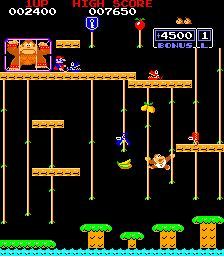 | Donkey Kong Jr.
(1982) | The 2nd game in the Donkey Kong series, and the 2nd appearance of Mario. Ironically, in this game, Mario plays the villain. 4 different screens, just like the original Donkey Kong. |
Clones: | Coco Title | Comments |
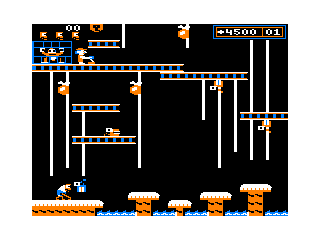 | Junior's Revenge
(1983) | While it has all 4 screens, and the intermissions, it isn't quite graphically as good as Donkey King, and the music is missing. Still, a very good clone. |
 | Return of Junior's Revenge
(1986) | A remake of Junior's Revenge, enhanced for the Coco 3's graphic capabilities. The same sound routines, etc., but much better graphics. One of the first (if not the first) 3rd party Coco 3 game out, it was released within just a few months of the Coco 3 itself. |
The Electric Yo-Yo |
Arcade Original: | Title
(Released) | Comments |
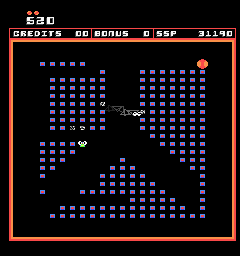 | The Electric Yo-Yo
(1982) | Collect the dots, while stringing across between them, and avoiding various enemies. |
Clones: | Coco Title | Comments |
 | Beam Rider
(1983) | An almost exact clone of a fun, but not overally successful or popular, arcade game. |
Food Fight |
Arcade Original: | Title
(Released) | Comments |
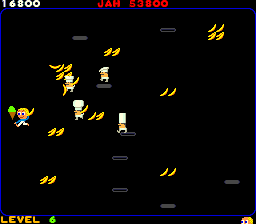 | Food Fight
(1983) | A fun game where you run around the screen having a food fight with chefs, and try to eat the ice cream cone. |
Clones: | Coco Title | Comments |
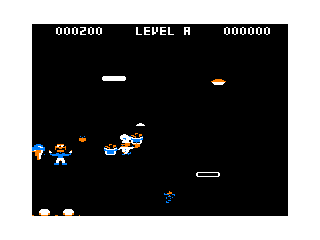 | Foodwar
(1983) | A rather quick turnaround for releasing this clone (release the same year as the orignal), and pretty close to the arcade game in play and graphics (less colors, obviously). |
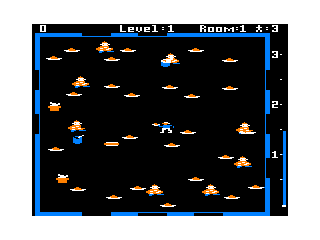 | Mudpies
(1983) | A bit different from Foodwar, in that you are fighting clowns instead of Chefs, and there numerous bonus shapes (that you can't throw) scattered on the screen. Added a humourous interlude of you getting hauled off on a stretcher when you get hit. |
Frogger |
Arcade Original: | Title
(Released) | Comments |
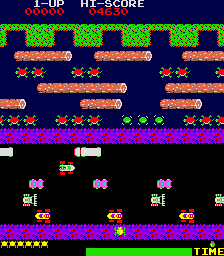 | Frogger
(1981) | Guide your frog across a busy highway and fast running stream to safe havens on the other side. |
Clones: | Coco Title | Comments |
 | Frog Trek
(December 1982) | An early clone that plays at a 90 degree angle to the arcade original (the player moves left to right), it has the basic elements of Frogger, but with rudimentary sound and keyboard controls are a bit laggy. An odd part is that traffic only moves in the lanes closest to you; the others pause once you are far enough away. |
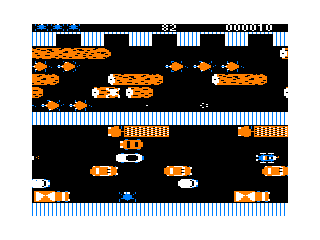 | The Frog
(May 1983) | Visually in some ways superior to the arcade original (rolling logs, exhaust and windshield wipers on cars, turtles swim), the sound effects sound like they were made in BASIC, and the keyboard only controls are laggy. |
Derivative
Games: | Coco Title | Comments |
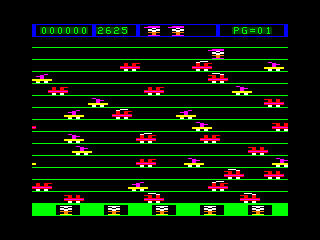 | Rail Runner
(October 1982) | While the gameplay is similar to Frogger, the theme is different - you are a Hobo trying to cross many rows of railway tracks to get to the safe zone on the other side. Very colorful using the Semigraphics-24 mode. |
 | Frogjump
(May 1983) | A BASIC/ML hybrid from T&D tape magazine, the very minimum of Frogger is here - cross the road and river safely to the other side. No snakes or alligators, no scoring (except for how many frogs have made it) and jerky movement makes it difficult. |
 | Rainbow Roach
(May 1983) | Another BASIC/ML hybrid this time from Rainbow magazine. This version features 4 skill levels that vary the speed of the scrolling platforms that the player has to navigate through, and they are very crowded, making the game much more difficult than Frogger. You also have a timer when you are in the rows between the platforms of objects; the spray can in the upper left goes down and if it reaches the bottom it will spray and kill you. |
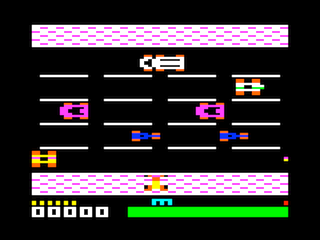 | Jumping Joey
(November 2022) | A modern re-imagining with an distinctly Australian theme. This version features a lower Semigraphics mode to keep the color count high and smooth scrolling while also allowing background music and sound effects playing at the same time with no slowdown. Because of the lower resolution, the original Frogger screen is broken into two (highway and river) but it also adds a unique 3rd screen as well (the ranch) with some different gameplay mechanics. |
Galaga |
Arcade Original: | Title
(Released) | Comments |
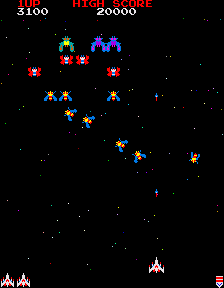 | Galaga
(1981) | Itself a sequel to Galaxian, Galaga added bonus waves, the ability of your ship to get captured (if you captured it back, you would get to use two ships simultaneously, and get double the fire power), and stats on your shooting percentage. |
Clones: | Coco Title | Comments |
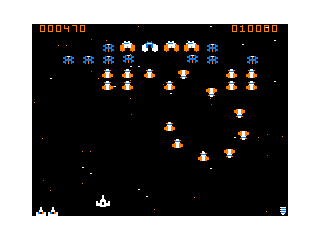 | Galagon
(1984) | This Spectral Associates version played very close to the arcade, including the bonus waves, stats and ship captures. Basically it was just missing the sound. |
Derivative
Games: | Coco Title | Comments |
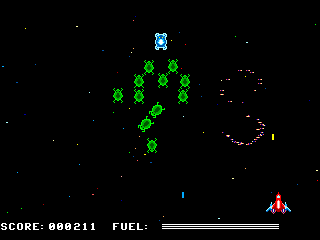 | Zenix
(1989) | This is one of those rare instances where the Coco version blew the arcade version out of the water. It had the shooting percentages and bonus waves (but no ship capturing) of Galaga, but added better sound (including multi-voice music while you played), much faster game play, fuel (which powered your shields), large bosses, various power ups (multi-shot, armor penetrating shots, fuel, etc.), and the ability, at the end of the game, to destroy the home planet of the invaders. Still one of the technically most advanced Coco 3 games ever made. |
Galaxian |
Arcade Original: | Title
(Released) | Comments |
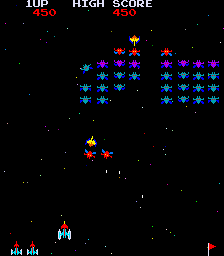 | Galaxian
(1979) | The first arcade game with real full colour (no overlays) and expanded on the Space Invaders concept by allowing aliens to break formation. |
Clones: | Coco Title | Comments |
 | Birds
(1982) | This Tom Mix version, which plays close the original in concept, changed the scenario so that you are a hunter trying to shoot down a flock of birds. |
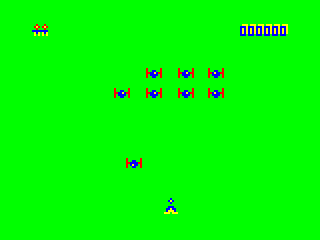 | Galactic Attack
(1982) | Tandy's version had much simpler game play with only 8 aliens in the armada, although they are more mobile than the arcade version. It also featured "night bombing" runs with a different colour palette. |
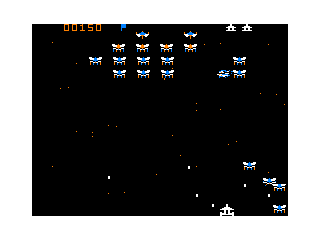 | Galax Attax
(1982) | Much faster playing than the original arcade version. The first released version had aliens that looked quite a bit different than the arcade, but the revised version came much closer in appearance. |
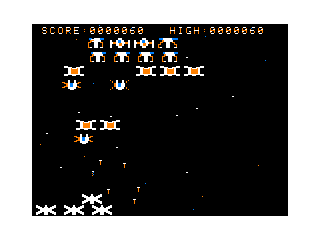 | Space Ambush
(1982) | Completely different shapes, but the gameplay is pretty close to the arcade game. |
Derivative
Games: | Coco Title | Comments |
 | Glaxxons
(1983) | Mark Data Products expanded on the Galaxians concept with some innovations of their own. Each player (up to 2) could play at their own skill level, and you have some vertical movement at the bottom of the screen. Also, if you fire a 2nd shot while the first is still travelling, you're original bullet disappears and is replaced with the new one (like Gorf in the arcades. |
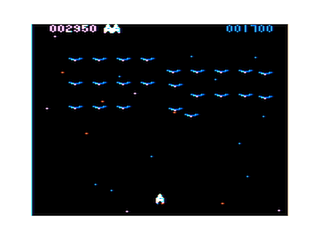 | Space Hawk
(early 1985) | This derivative appeared in the February 1985 issue of Hot Coco magazine. The main difference with this version is that the first wave has 5 aliens, and it increases by 5 more each following wave until 25. The aliens don't dive in specific formations, either. |
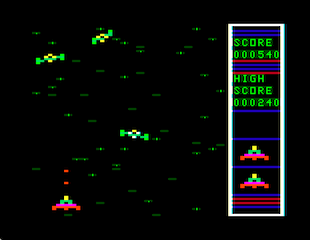 | Star Swoop
(1985) | This derivative first came out for the Dragon 32/64. Using a higher semigraphics mode it allows 8 colors on the screen at once, as well as a scrolling, twinkling starfield. There are fewer aliens at once than Galaxian (and they come into play one at a time gradually gathering up in numbers), but the aliens also spin around which causes them to be narrower during the spin and harder to hit. |
Gauntlet |
Arcade Original: | Title
(Released) | Comments |
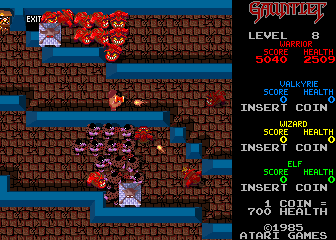 | Gauntlet
(1985) | Probably the biggest RPG arcade game of all time, allowing up to 4 players simultaneously. |
Clones: | Coco Title | Comments |
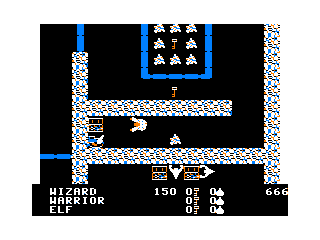 | Gantelet
(1986) | This Diecom version even supported the Sound/Speech Pak to speak out loud like the arcade original did, and supported up to 3 players at once (2 on joysticks and 1 on keyboard). No music though. |
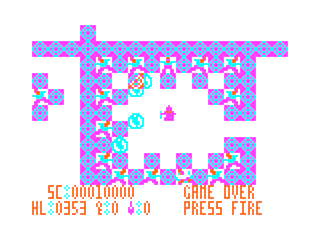 | Glove
(2007) | This commercial version developed for the Coco's and Dragons simultaneously is a well done version that is lower resolution than Gantelet, but will even run on 32K RAM machines (the Diecom one requires 64K). It features more sound effects too, but only 2 players at once. |
Gauntlet II |
Arcade Original: | Title
(Released) | Comments |
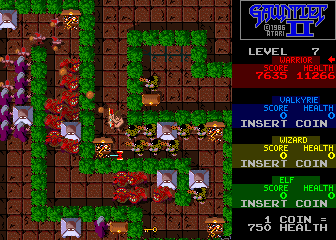 | Gauntlet II
(1986) | The sequel to probably the biggest RPG arcade game, allowing up to 4 players simultaneously. |
Clones: | Coco Title | Comments |
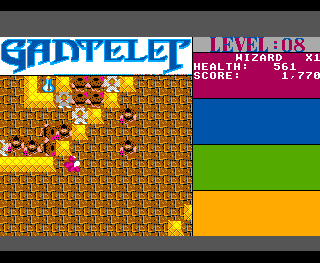 | Gantelet II
(1988) | This Diecom version came really close to the arcade with Coco 3 graphics, digitized sound effects, and even up to 4 simultaneous players (2 on joysticks, 2 crammed on the keyboard). About the only things missing are the music, and the voices. |
Gravitar |
Arcade Original: | Title
(Released) | Comments |
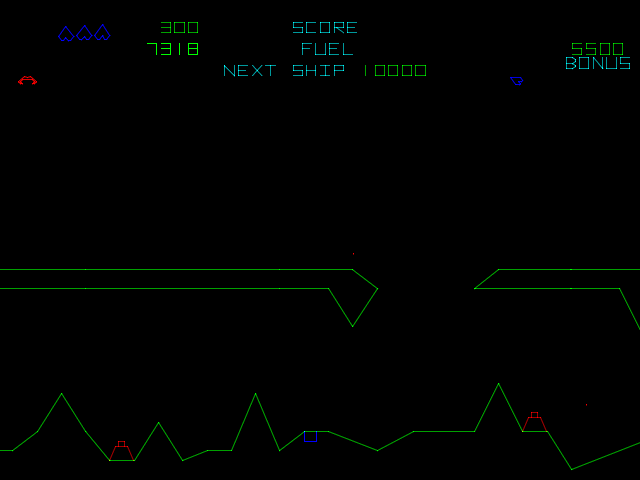 | Gravitar
(1982) | A color vector game by Atari with controls similar to their earlier smash Asteroids. But with gravity and planetscapes that you have to maneuver through as well.. |
Clones: | Coco Title | Comments |
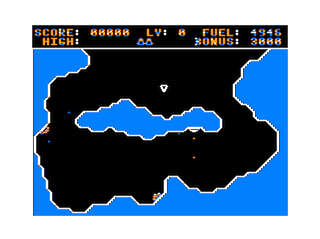 | Gravitor
(1983) | Aside from missing the vector zoom effect that the arcade original had, and having completely different planet surfaces, this version is surprisingly faithful to the arcade original, with the same mixture of planet types and game play. And quite good sound. |
Ikari Warriors |
Arcade Original: | Title
(Released) | Comments |
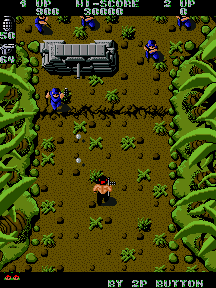 | Ikari Warriors
(1986) | You have to raid an enemy compound and rescue prisoners of war. |
Clones: | Coco Title | Comments |
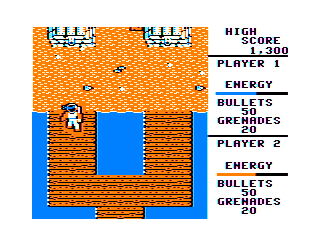 | Rush'N Assault
(1988) | A close clone (given the limitations of Coco 1/2 graphics), including two players at once. No background music, either. |
Joust |
Arcade Original: | Title
(Released) | Comments |
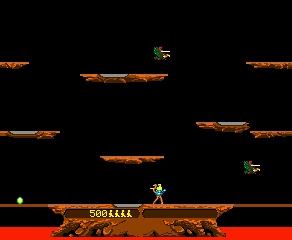 | Joust
(1982) | The first arcade game that had both cooperative and dueling modes for two players at the same time. |
Clones: | Coco Title | Comments |
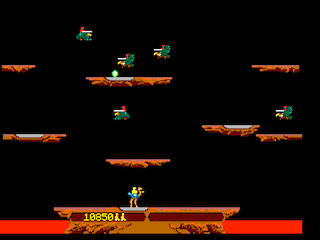 | Joust
(2021) | An exact clone, because it is the original arcade ROM's running on the identical 6809 chip (with the sprite, sound and I/O chips handled through software emulation). This is the arcade game, and even includes some extra configuration options that the arcade version didn't have. A must have for a Coco 3 owner with at least 512K RAM. The only slight difference is the palette; the original had 256 colors to choose from, not 64. |
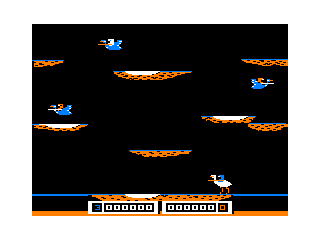 | Buzzard Bait
(1983) | The closest clone, and fastest playing, version on the Coco. It even has the hands that try to grab you from the lava pits (Lancer just makes you sink). |
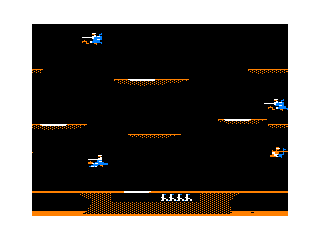 | Lancer
(1983) | Game play is slower than Buzzard Bait, but still very playable, and, to me, it had a better feeling of "flight". |
Derivative
Games: | Coco Title | Comments |
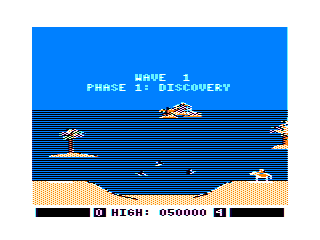 | Pegasus and the Phantom Riders
(late 1984) | A clone that actually went a little further than the original arcade. With detailed backgrounds, and a 3D element added (your opponents fly in from the distance, and as you progress, you get closer to their island), it looked and felt more sophisticated than the original. By the same company that made Lancer, but a different author, and sold through Radio Shack/Tandy. |
Juno First |
Arcade Original: | Title
(Released) | Comments |
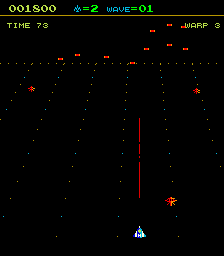 | Juno First
(1983) | A pseudo 3D space shooter where you fly in all directions shooting waves of aliens. |
Clones: | Coco Title | Comments |
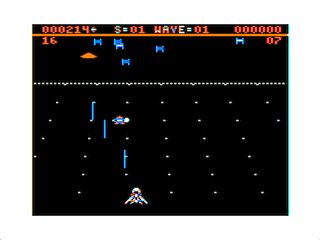 | Juno
(Early 1985) | A close clone with a bonus training mode. |
Karate Champ |
Arcade Original: | Title
(Released) | Comments |
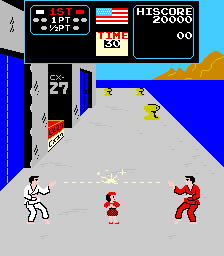 | Karate Champ
(1984) | A simultaneous 2 player game, pitting the two players against each with a wide variety of moves, this was one of the first such martial arts games that started the whole sub-genre. The referee rates the players with full and half points depending on their moves, similiar to real tournaments. |
Clones: | Coco Title | Comments |
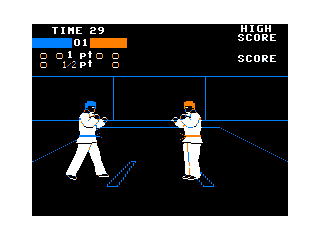 | Karate
(1985) | While not having as fancy of graphics (and almost no background compared to the arcade original), Karate nevertheless maintained fairly close gameplay with the variety of moves that could be done with the joystick controls. |
Derivative
Games: | Coco Title | Comments |
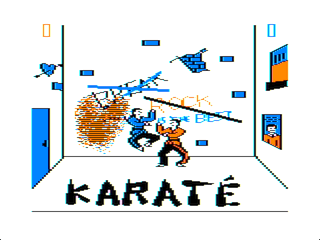 | East-World Karate
(Late 1987) | A very impressive version for being written mostly in BASIC, this version supports 1 or 2 players, improved response time on a Coco 3, some digitized sound effects and user-selectable background scenes (16 of them). |
Ladybug |
Arcade Original: | Title
(Released) | Comments |
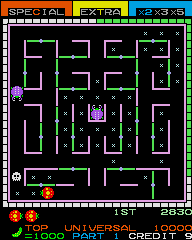 | Ladybug
(1981) | With a starting concept similiar to Pac Man, in this game you have to collect the dots, while avoiding your enemies. Added to the Pac Man concept is the bonus multipliers, spelling out the words "SPECIAL" and "EXTRA" (you have to eat them when they are the right color), and the fact that you can modify the maze by rotating the turnstyles (which the other bugs can not do). |
Clones: | Coco Title | Comments |
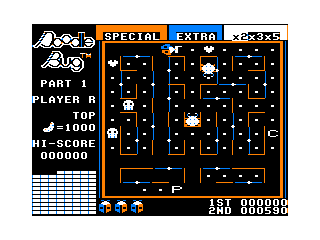 | Doodle Bug
(1982) | An almost exact clone of the arcade hit.The only minor difference is that the timer bars are all on the left, while they go around the maze in the arcade version (to time the colors of your bonus shapes to pick up). |
Marble Madness |
Arcade Original: | Title
(Released) | Comments |
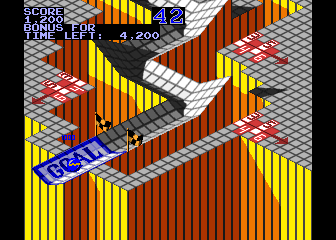 | Marble Madness
(1984) | An isometric 3D maze game where you guide your marble to the finish line within a time limit. |
Clones: | Coco Title | Comments |
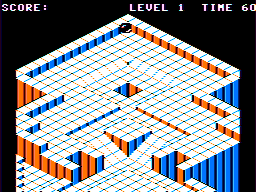 | Marble Maze
(1985) | Marble Maze is a very close clone of the arcade version, given the limitations of the Coco 1/2 hardware. It ran slower than the original, but captured all of the essential arcade version game elements. |
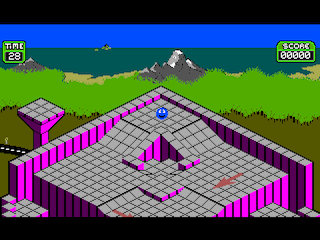 | Those Darn Marbles
(1990/1991) | Those Darn Marbles utilized both 512K and GIME Coco 3 enhancements (like 16 colors and hardware scrolling) to much more closely match the arcade original, while adding quirky humor (which the authors referred to as the "Planet of Enquirer Graffiti"). |
Millipede |
Arcade Original: | Title
(Released) | Comments |
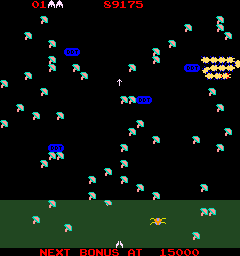 | Millipede
(1982) | A sequel to the hugely popular Centipede, Millipede added some extra elements (like DDT bombs) and new insects to contend with. |
Clones: | Coco Title | Comments |
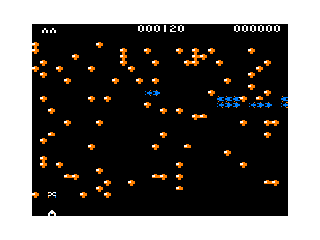 | Kingpede
(1987) | Kingpede added the new insects from Millipede, and is the only Coco clone of the arcade game that I know of. This makes it even more surprising that Kingpede was not sold as a standalone game, but as a game included with one of the issues of the T&D tape magazine. |
Monaco GP |
Arcade Original: | Title
(Released) | Comments |
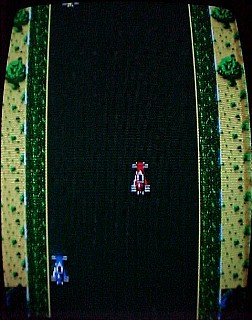 | Monaco GP
(1980) | A simple vertically scrolling racecar game, with things like night driving (limited view ahead of the car) and extended play if your score was high enough thrown in. The last game to be released in the arcades without a CPU - it used all analog circuitry. This is also why this screenshot is from an actual camera - there is no CPU for an emulator to emulate. |
Clones: | Coco Title | Comments |
 | Morocco GP
(1983) | A fairly close clone; it included the night driving, extended play, ice driving and country driving. The crashing sequence could get annoying after awhile, though... |
Mr. Do |
Arcade Original: | Title
(Released) | Comments |
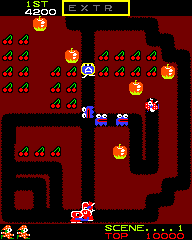 | Mr. Do
(1982) | Mr. Do is loosely based on the arcade hit Dig-Dug, but with a lot of extra elements of it's own. Like Dig-Dug, one has to dig underground, and kill your enemies (either by crushing them with apples, or shoot them with a richoceting ball), and also collect all the cherries. |
Clones: | Coco Title | Comments |
 | Mr. Dig
(1984) | A close clone, play-wise and graphics-wise, to the arcade original. Includes the gathering of letters to get free men and/or extra points. The only major differences are that it is missing the intermissions that the arcade original had, and that the maze layouts are slightly different (due to the size difference of the display screens). |
Nibbler |
Arcade Original: | Title
(Released) | Comments |
 | Nibbler
(1983) | Nibbler is kind of a combination of PacMan and the Snake games that used to come built in to every cell phone. You navigate a maze with your snake, trying to eat the food, but your tail grows longer the more you eat, and you can not bite your own tail. |
Clones: | Coco Title | Comments |
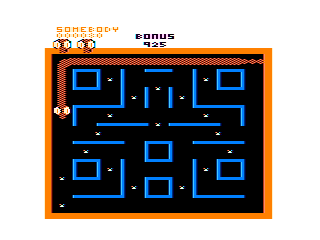 | Buzzworm
(late 1984) | A close clone, play-wise and graphics-wise, to the arcade original. It was sold by Novasoft, the "cheaper software" division of Tom Mix Software. It also includes bonus rounds every 5th screen. |
Derivative
Games: | Coco Title | Comments |
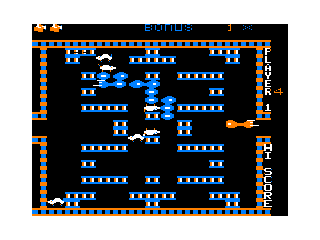 | Rat Attack
(October 1984) | A derivative with added features. There are Pac Man style tunnels added to the sides, and there is a computer controlled snake in addition to your own that you also have to avoid. |
Omega Race |
Arcade Original: | Title
(Released) | Comments |
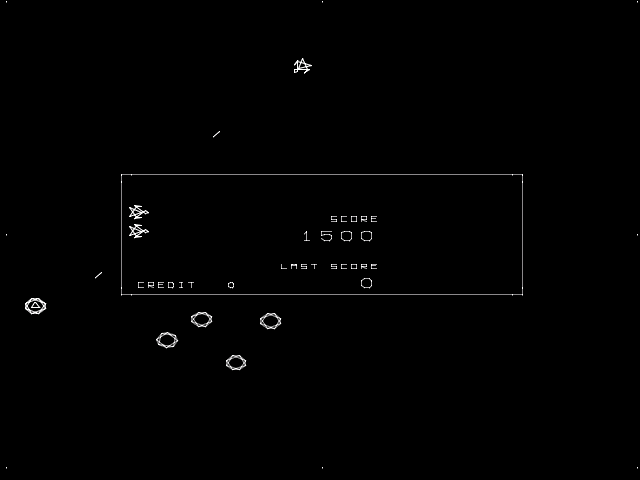 | Omega Race
(1981) | Using vector graphics similiar to Asteroids, Omega Race combined some different game styles into a unique combination. It has sort of a race track that you can circle in any direction, but with alien ships and mines all trying to destroy you. |
Clones: | Coco Title | Comments |
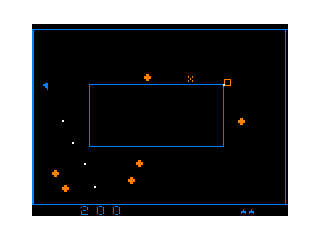 | Space Race
(1982) | Aside from the fact that Space Race is much lower resolution than a vector graphics game and it added color, it is a close clone playwise to the arcade original. |
Pac-Mania |
Arcade Original: | Title
(Released) | Comments |
 | Pac-Mania
(1987) | Namco greatly expanded the standard Pac-Man eating dots in a maze by transforming the game into a 4 way, 3-dimensional isometric view, adding the ability to jump, and multiple mazes. |
Clones: | Coco Title | Comments |
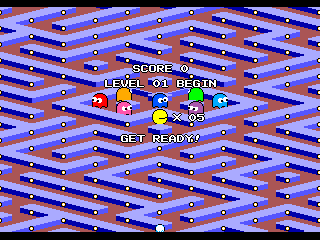 | Pacdude Monster Maze
(1992) | A 512K Coco 3 exclusive that, like the arcade version, features 4 way hardware scrolling in an isometric maze and multi-voice music running in the background, multiple mazes and the added ability to jump. The angle of the isometric display is (to me) better than the arcade original, and you can see more of the maze at a time which I also prefer. |
Paperboy |
Arcade Original: | Title
(Released) | Comments |
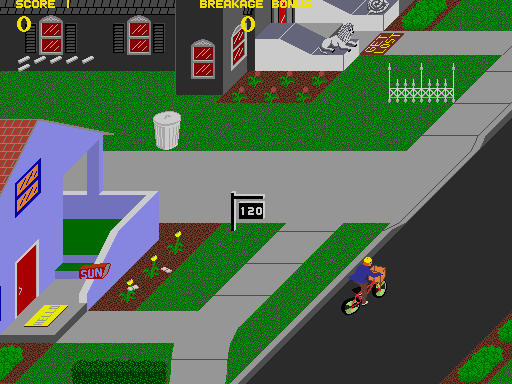 | Paperboy
(1984) | A rather unique game where you are a paper delivery boy going through urban areas, throwing newspapers into the mailboxes of your customers (but only those that have actually paid for it). You have to dodge cars, other people, etc. whilst on your route. |
Clones: | Coco Title | Comments |
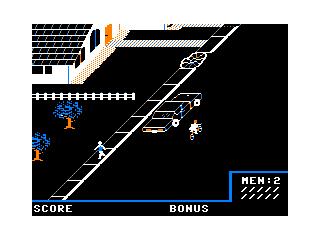 | Paper Route
(1985/1986) | A close clone of the arcade game, given the limitations of the Coco 2 compared to the arcade version (which had literally 4 times the screen resolution, and far more color). |
Pengo |
Arcade Original: | Title
(Released) | Comments |
 | Pengo
(1982) | A cute game by Sega that is fairly unique in game play, where you push ice blocks to crush Sno-bees. There are also 3 special blocks that you get a bonus for aligning together, and a timer based bonus as well. |
Clones: | Coco Title | Comments |
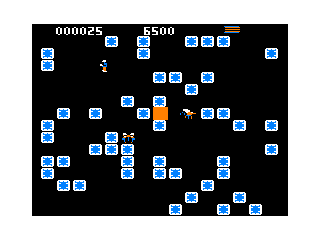 | Ice Master
(1983) | A fairly close clone of the arcade game, although here you play a human crushing mosquitos (which just feels more satisfying). While it does include the timer, it does not have the special special blocks to align. It does feature 3 different skill levels. |
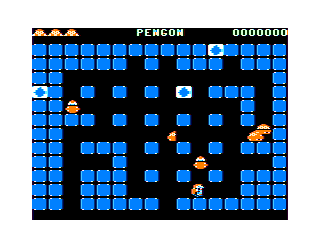 | Pengon
(1983) | Pretty well and exact clone of the arcade, with the 3 special blocks included and maintaining the penguin theme of the arcade original. It has some multi-voice music in the intro, and some graphically animated transitions. It is a more polished clone than Ice Master, and even has 5 skill levels. |
Phoenix |
Arcade Original: | Title
(Released) | Comments |
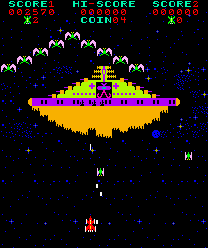 | Phoenix
(1980) | Expanding on the Galaxian concept, Phoenix had 5 different waves of aliens, including some that you would just injure if you didn't shoot them dead center. The 5th wave was tackling the mothership, where you have to shoot the aliens that are protecting it, and then shoot through the hull of the ship, the rotating barrier beyond that, and then the head alien himself. You also have a shield that you can activate, but it takes 7 seconds to recharge it after it wears out. |
Clones: | Coco Title | Comments |
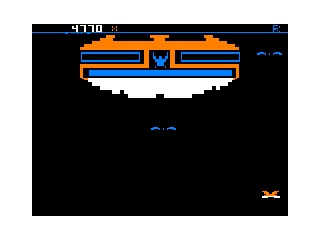 | Demon Seed
(1983) | An almost exact clone of the arcade hit.The only minor differences are that space is completely black (no starfield), and that, going with the demon instead of bird motif, you are combatting bats and demons. |
Popeye |
Arcade Original: | Title
(Released) | Comments |
 | Popeye
(1982) | A multi-screen game in the same vein as Donkey Kong, but based on the famous characters from the cartoons. You had to rescue Olive Oil, while avoiding Brutus, the sea hags, and other obstacles. |
Clones: | Coco Title | Comments |
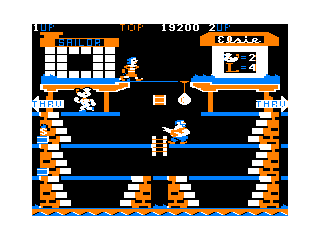 | Sailor Man
(1984) | Like the author's (Chris Latham) other brilliant game (Donkey King), Sailor Man was an almost exact clone of the arcade hit, even including multi-voice music and excellent animation, as well as all 3 screens from the arcade version. It was also the first commercial game for the Coco 1/2 that required 64K, and one of the first to allow a lot of customization options (and different between each player), and saving high scores to disk. |
Punchout |
Arcade Original: | Title
(Released) | Comments |
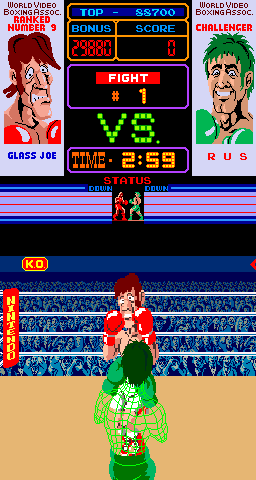 | Punchout
(1984) | A unique boxing game, which had two separate screens in the arcade cabinet (the top one showed stats, your opponent, etc., and the bottom showed you (semi-transparent) in the ring. You gradually worked your way through tougher and tougher opponents in order to get to the #1 ranked boxer in world, punching and dodging on your way. |
Clones: | Coco Title | Comments |
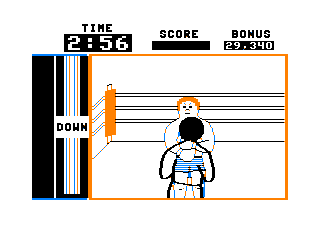 | Knockout
(1985) | A really good clone of the arcade hit, including the moves, and multiple opponents, as you proceed in the game. One of Diecom's earliest 64K games. |
Qix |
Arcade Original: | Title
(Released) | Comments |
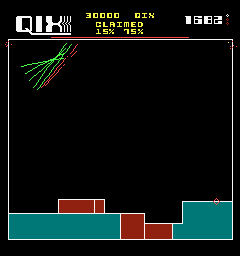 | Qix
(1981) | An original concept at the time of it's release, Qix had the player trying to paint in a certain percentage of the screen by drawing (with 2 speeds of movement) lines. Once an area was completely enclosed by the player's lines, it filled in. Various enemies move around the screen or track the player (more at later levels). |
Clones: | Coco Title | Comments |
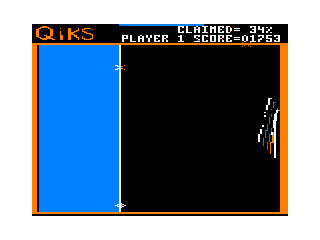 | Qiks
(1984) | An almost exact clone of the arcade hit, with the Qiks itself (the moving set of lines) looking like the arcade version. |
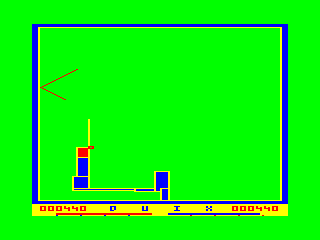 | Quix
(1984) | Also a close clone of the arcade original, except that the Quix is a single bouncing line instead of a group of lines, and the colour set used is a lot different. |
Derivative
Games: | Coco Title | Comments |
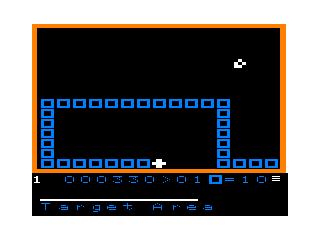 | Arex
(1983) | While the basic concept is the same (fill in a certain percentage of the screen while avoiding enemies), Arex differs by having you fill in the screen by leaving a trail (the large blocks in the screen shot). On later levels, some of the screen is pre-filled in with patterns that you have to work around. Also, unlike Qix, you can not backtrack on your trails... you must always be creating new trails (which is why you can dead-end yourself in Arex. |
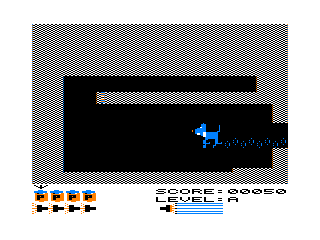 | Crazy Painter
(1983) | Like Arex the basic concept is the same (fill in a certain percentage of the screen while avoiding enemies), but you draw a trail to fill it in (you don't fill in by outline). Differences with both Qix and Arex is that you have to fill in the whole screen, you have a limited amount of paint (you have to get bonus shapes to get more), and you can "waste" paint on areas that you have already covered. Also, the dog can come by and get footprints in your paint, so you have to refill those areas. |
Rastan |
Arcade Original: | Title
(Released) | Comments |
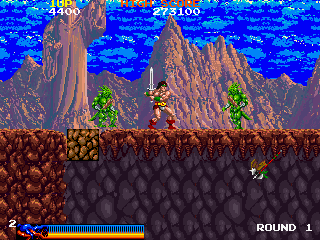 | Rastan
(1987) | Rastan was an arcade homage to role playing games like Dungeons and Dragons. You quest through 4 way scrolling terrain, picking up weapons and health, and defeating monsters during your quest. |
Clones: | Coco Title | Comments |
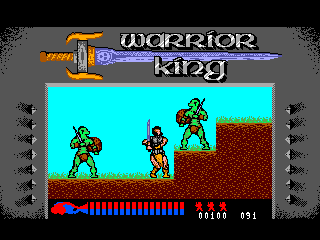 | Warrior King
(1988) | A fairly close clone of the arcade, although the appearance is blockier (and smaller, only using part of the screen), and the action is slower and less fluid than the arcade original. It does feature digital sound effects, and pretty good graphics. It was one of Sundog Systems first games that was Coco 3 specific. |
Ripoff |
Arcade Original: | Title
(Released) | Comments |
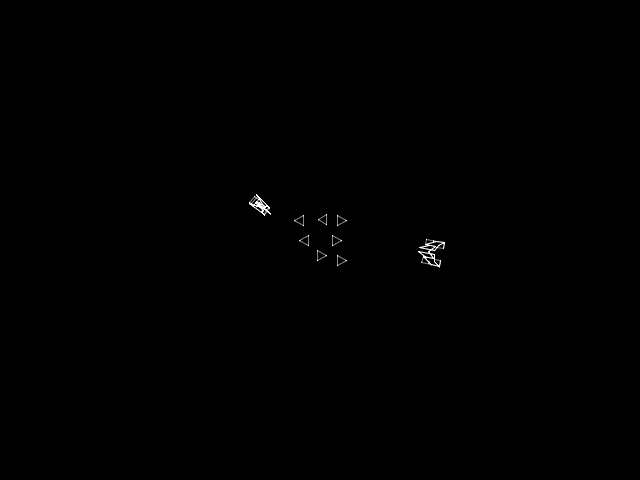 | Ripoff
(1980) | Ripoff was a vector based arcade game where one has to protect all the fuel canisters in the middle from being stolen by aliens, with whom you can also collide with and they will shoot at you. It also featured simultaneous 2 player action. |
Clones: | Coco Title | Comments |
 | Gazon
(1982) | Pretty close to the arcade original, although in color and lower resolution. Actually used the analog joysticks as analog, allowing 32 different directions of movement. Missing the 2 player simultaneous, though. |
Scramble |
Arcade Original: | Title
(Released) | Comments |
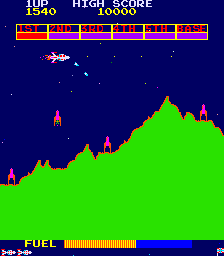 | Scramble
(1981) | A 1 way scrolling, sideways shooter, Scramble had the player trying to navigate through both open air and a cave system, blowing opponents up (and fuel stations for extra fuel), with both bombs and bullets (downwards and forward shooting directions, respectively) while also dodging the terrain. There are 5 stages, and at later levels, one is going through very narrow tunnels, where the terrain itself is more dangerous than your opponents. |
Clones: | Coco Title | Comments |
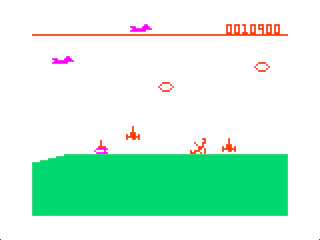 | Air Attack
(1984/1988) | A lower resolution version that was sold as one of the programs in an issue of T&D tape magnazine (July 1988 issue, even though the game had been submitted in 1984), Air Attack was a fairly close clone of the arcade original, although using the "pastel" color set. Since it was part of a magazine, it was by far the cheapest Scramble clone on the Coco. |
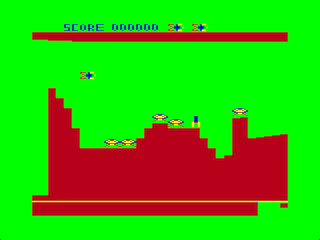 | Cave Fighter
(1983) | This clone originally came out for the Dragon 32 computer in the UK, and has some advance features like digitized speech at the start of the game. It did have one little twist added from the arcade game: "Force Walls" that you have to shoot through (quickly!) to get through it and get further into the cave levels. |
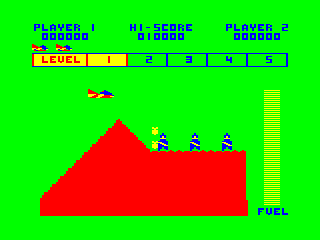 | Skramble
(1983) | A close clone of the arcade original, it suffered a little bit of having jittery position of the player (it scrolled the entire play area from right to left including the players ship, and then move the ship back to where it was supposed to be). Other than that, it played and resembled the arcade original very closely. |
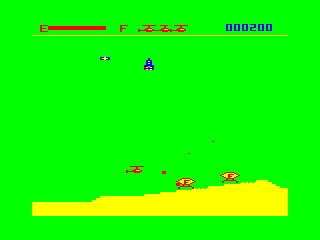 | Whirlybird Run
(1982) | The first Scramble clone for the Coco, and still my favourite. Whirlybird Run made much smoother use of sideways scrolling, and was actually the 1st place winner in Spectral Associates 1st (and only) programming contest, netting it's author the $2,000 prize and publishing of the game. Although the screen layout varies more from the original than Skramble, the game played much smoother. It also used the green/yellow/blue/red palette for the "outdoor" levels (the first 3), and the black/blue/red/white for the cave sequences (the last 2). |
Derivative
Games: | Coco Title | Comments |
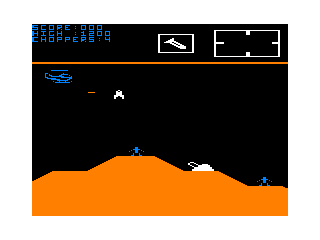 | Chopper Strike
(1983) | While the basic concept is the same (flying over terrain, blowing up both airborne and ground based targets), Chopper Strike added in rescuing stranded humans, ala Defender. You could also shoot a human by accident, immediately causing you to lose a life. You also only have one type of shot that you aim, not two types. The last change is that the whole terrain is one continuous scrolling landscape. |
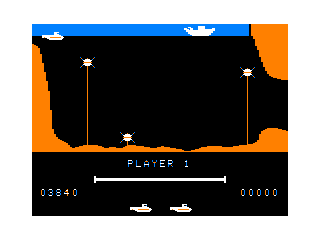 | Sea Dragon
(late 1982) | Switching to an underwater theme (still with caves to navigate through on later levels), Sea Dragon also added the concept having to keep your air supply supplied, so you have to surface at times to replenish it. There is also a boss at the end of the game - a well guarded nuclear reactor. |
Sinistar |
Arcade Original: | Title
(Released) | Comments |
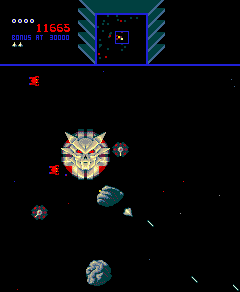 | Sinistar
(1982) | Expanding on the Asteroids concept, Sinistar adds mining asteroids, and competing with aliens for the crystals contained therein. The aliens are building a massive robot ship called the Sinistar that will go after you with a vengeance once it is completed, and you are collecting enough of them to make Sini-bombs to destroy the Sinistar. You also have a radar (similiar to Defender) to try and keep tracking of asteroids, aliens and the Sinistar itself. |
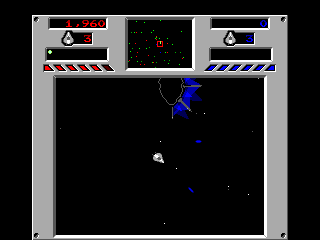 | Sinistaar
(1989) | An almost exact clone of the arcade hit, right down to digitized voices and sounds taken straight from the arcade. The major difference is that it plays a lot slower than the arcade original, which was quite fast. |
Space Encounters |
Arcade Original: | Title
(Released) | Comments |
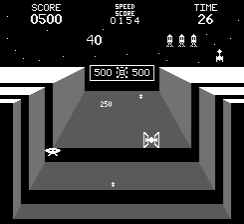 | Space Encounters
(1980) | Obviously based on the Star Wars trench sequence, Space Encounters had you flying in the trench, to blow up the death star. An early 3-D perspective game, it had a cool sequence when you were hit, where it expelled you out of the trench into orbit, then brought you back in. |
 | The Force (also known as Intergalactic Force)
(1982) | A colorized clone of the arcade game, although it did not include the "expelling from the trench" sequence. |
Space Wars |
Arcade Original: | Title
(Released) | Comments |
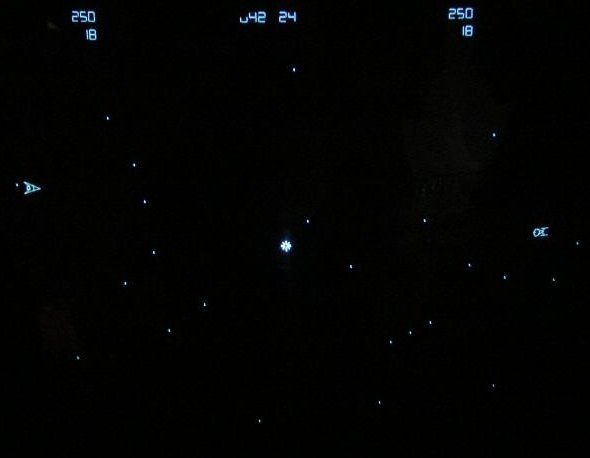 | Space Wars
(1977) | An arcade version of one of the very first video games ever made (the original PDP mini-computer version was done way back in 1961-1962), Space Wars was a vector based arcade game for 2 players only. Featuring inertia, and the gravity of a star in the center that could pull your ships in, the arcade version had multiple options that the player could set before starting the game. |
Clones: | Coco Title | Comments |
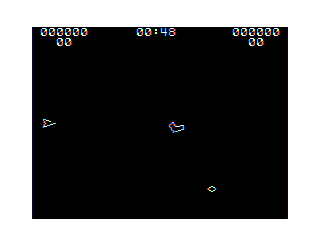 | Space War (Greg Zumwalt)
(1982) | An early clone which followed the arcade version more closely than some others by including the time limits (which you could extend as you play (like the arcade version did if you deposited more quarters). It did not feature a background starfield or all of the gameplay customizations of the arcade game. |
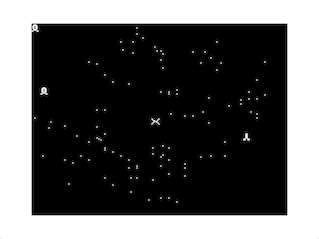 | Space War (Rich Natili)
(2021) | A modern release I believe more based on the PDP original (there is no scoring or time limits; it merely keeps track of the number of kills for each player), but it does have the starfield background made of real constellations like the arcade. |
Derivative
Games: | Coco Title | Comments |
 | Space War (Spectral Associates)
(1981) | At first glance it looks a lot like other Space Wars clones, but it features a lot of extra things like a rotating death star with a shield, space mines, meteors, cloaking for the player, and gun fire direction independent of the ship movement. It is also single player only. |
Space Zap |
Arcade Original: | Title
(Released) | Comments |
 | Space Zap
(1980) | The arcade game featured a fixed base in the middle of the screen, with the player moving a turret and firing in one of four directions to destroy enemy shots and two different enemy types. |
Clones: | Coco Title | Comments |
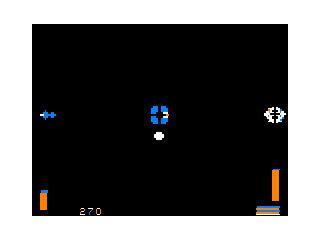 | Color Zap
(August 1982) | An early clone which added the feature of the player's based overheating if they fired too rapidly (usually due to the autofire that the game supported). |
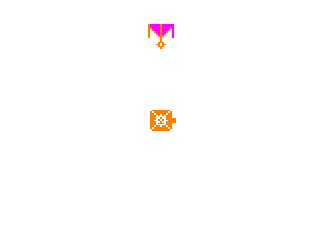 | Space Zapper
(February 1982) | The first clone of Space Zap for the Coco, this game played suprisingly well for being written in Extended BASIC with no machine language whatsoever. |
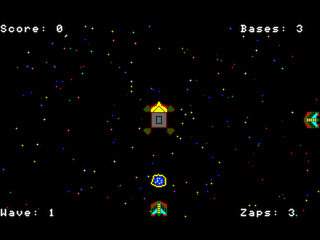 | Space Zap (OS-9)
(1990) | A Coco 3 version written for OS-9 Level II using BASIC09, this version gets quite fast and is more colorful than the arcade original, and adds a "SuperZap" that will destroy all ships and shots on the screen. It also features a top 10 score list. |
Sprint 2 |
Arcade Original: | Title
(Released) | Comments |
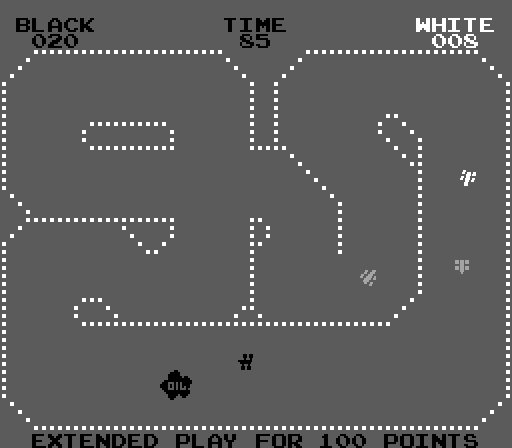 | Sprint 2
(1976) | Sprint 2 (the "2" is the number of players, not a sequel number) is a classic grey scale 1970's arcade game for 2 players, driving around multiple race tracks with obstacles in the way - including the other player. As with most games of this time period, it was based on time per quarter and not the number of lives. |
 | Le Mans
(1982/1983) | A color version of the arcade original, with top 10 scores and 16 skill levels and 1 or 2 players. The object is to make 20 laps the fastest, and there are jerry cans that the player can run over to get a free lap. The skill level affects how tight the player can take corners; level 15 gives wide arcing skids which is the most fun. |
Star Force |
Arcade Original: | Title
(Released) | Comments |
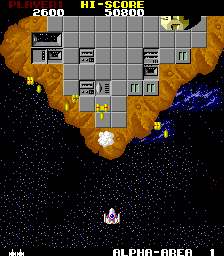 | Star Force
(1984) | Star Force is kind of expanded Xevious, with a lot more bonuses and different islands floating in space to travel between (kind of like Zaxxon except with a top down view). |
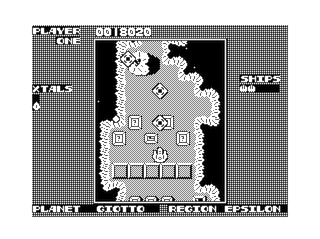 | Lucifer's Kingdom
(1988) | A surprisingly close version of the original, originally released for the Dragon 32/64. It runs in black and white and slower than the arcade original , but includes parallax scrolling (with the starfield background vs. the floating islands), and includes some further bonuses that I don't believe are in the arcade original. |
Super Sprint |
Arcade Original: | Title
(Released) | Comments |
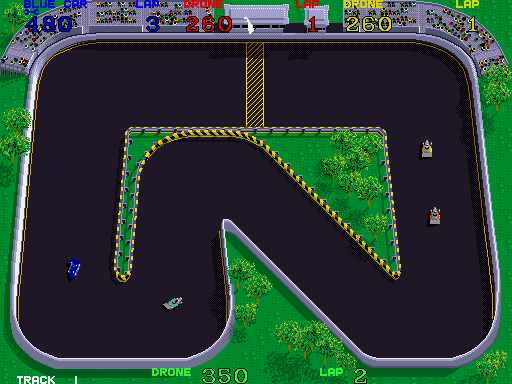 | Super Sprint
(1986) | Super Sprint was a much more advanced sequel to the original 1970's Sprint games; it featured much higher resolution (and color) graphics, up to 3 players simultaneously, and added in more hazards and road types, as well as the ability to pick up wrenches on the track so that you could boost attributes of your car (traction, maximum speed, acceleration, and points multiplier). |
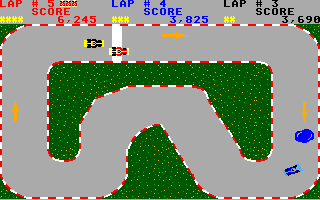 | Grand Prix Challenge
(1987) | One of the earlier Coco 3 titles, the game has 25 different tracks, up to 3 players, and has the wrench system with the same way of boosting the car attributes as the arcade original. Two things that make it less than stellar is it is almost completely devoid of sound, and runs rather slow. But it was done within a year of the Coco 3 being released and programmers were just learning the new hardware, so I will cut it a little slack.. |
Tapper |
Arcade Original: | Title
(Released) | Comments |
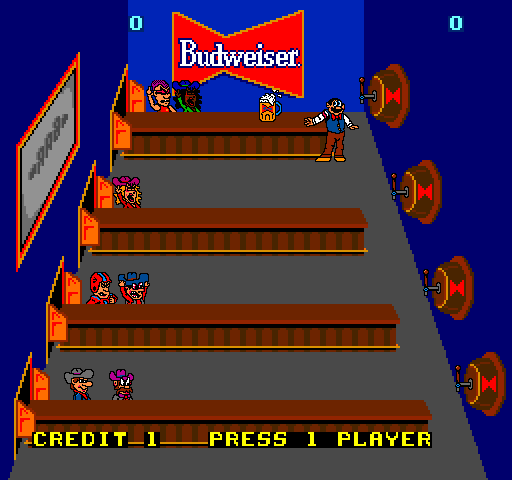 | Tapper
(1983) | An original game where one is a frenzied bartender serving patrons as fast as you can. Because of the link with alcohol, it was released again the following year as Root Beer Tapper. |
Clones: | Coco Title | Comments |
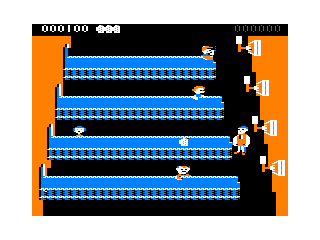 | Brew Master
(1986) | Fairly close to the arcade and includes bonus rounds like the arcade did. Was sold through Novasoft, a subsiduary of Tom Mix Software that sold software cheaper than it's parent company. |
Targ |
Arcade Original: | Title
(Released) | Comments |
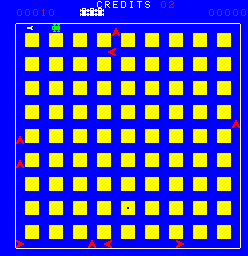 | Targ
(1980) | An original game where one traverses hallways in a grid shooting opponents and avoiding being shot. As time progresses, a different ship appears that is worth more points. |
Clones: | Coco Title | Comments |
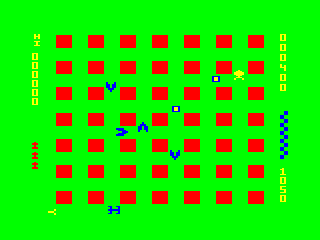 | Storm Arrows
(1983 (written 1982) | Fairly close to the arcade, although they could have literally matched the colors dead on (it has the same green/yellow/blue/red palette as the Coco, with white only used for free men & your and missiles). There is an additional feature - your opponents can also drop mines for you to run into (or shoot). |
Tempest |
Arcade Original: | Title
(Released) | Comments |
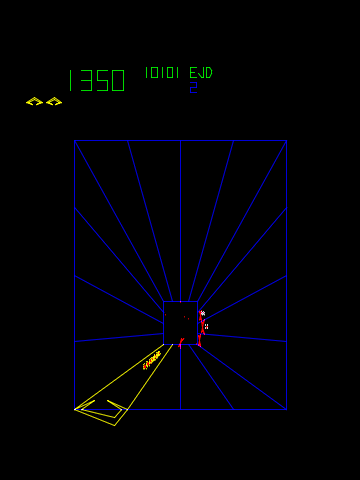 | Tempest
(1980) | An original game where one tries to prevent enemies from escaping from their hole to kill. The first color vector arcade game, and was actually inspired by a nightmare that the original programmer/designer had. |
Clones: | Coco Title | Comments |
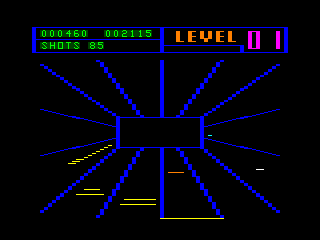 | Storm
(1982) | Except for the obvious difference in the resolution and quality of the graphics, Storm is a fairly faithful adaption of Tempest's gameplay. It is far less animated, and doesn't have as many enemies, though. |
Time Pilot |
Arcade Original: | Title
(Released) | Comments |
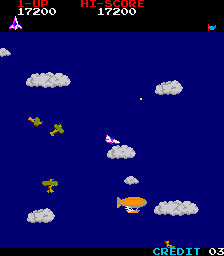 | Time Pilot
(1982) | A classic arcade game, where the player flies through clouds and shoots many opponents (including some larger boss ships) all while trying to rescue parachutists... and then travels in time to a future era with more powerful ships to deal with. There are multiple time periods to travel to, starting with World War I. |
Clones: | Coco Title | Comments |
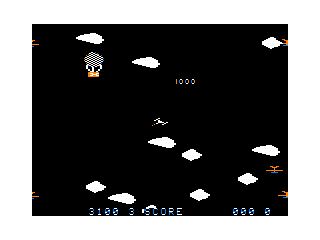 | Fury
(1983) | Although the steering is far more coarse than the arcade original, and the game plays choppier, it does have the different time periods, parachutists and even added in a little bit of software synthesized speech... even in the attract mode. |
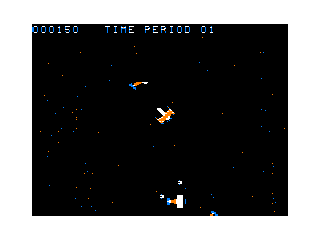 | Time Patrol
(1983) | Like Fury, this version restricts the number of angles you can fly at compared to the arcade original. It does feature the boss ships and different time periods, but there are no parachutists to rescue in this version.You are also flying at night, so the program didn't have to draw clouds. |
Time Pilot 84 |
Arcade Original: | Title
(Released) | Comments |
 | Time Pilot 84
(1984) | This supposed sequel to the classic Time Pilot really has nothing to do with the earlier game. It is more like a 4 way scrolling Xevious, where you fly over various alien terrain shooting and bombing multiple types of opponents, including large bosses. You then warp to the next planet (or part of a planet?). Fun, but probably should not have been called Time Pilot. |
Clones: | Coco Title | Comments |
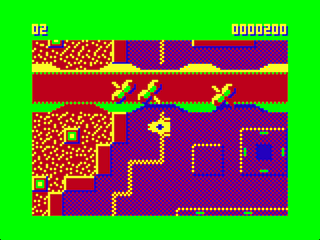 | Return of the Beast (ROTB)
(2017) | A very ambitious game for the Coco 1/2 and the Dragon, which features multiple terrains and aliens that sometimes fly in formation (like the arcade original), 4 way scrolling with 32 angles of flight, great sound effects and 3 channel music during the opening credits. Although lower resolution (128x96x4 to keep the speed up), it plays very well and is very impressive. |
Track and Field (Hyper Olympics outside U.S.) |
Arcade Original: | Title
(Released) | Comments |
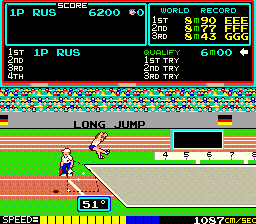 | Track &Field (aka Hyper Olympics)
(1983) | A complete button masher, you competed in 6 different sports events, and had to beat certain distances or times in order to qualify for the next event. |
Clones: | Coco Title | Comments |
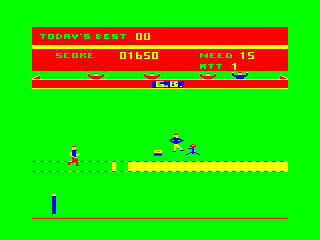 | Athletyx
(1984/1985) | A close clone of the arcade game, with 1 or 2 player options, and 7 events instead of 6. Released on the Dragon computers in England first, then ported to the Coco later. |
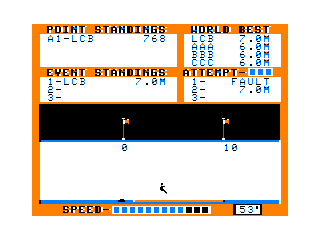 | Decathlon
(1984) | This version featured all 10 Decathlon events, and even allowed saving/re-loading high scores from tape. |
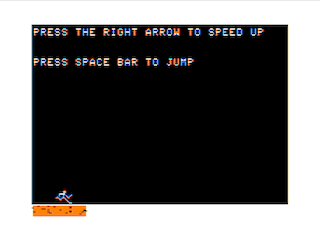 | Olympic Decathlon
(late 1984/1986) | This version also featured all 10 Decathlon events, but was much slower, being written in Extended BASIC (except for one ML scrolling subroutine). Not as good physics, either. |
Tron |
Arcade Original: | Title
(Released) | Comments |
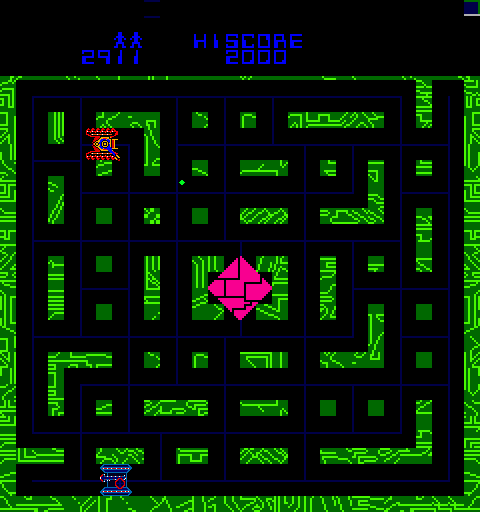 | Tron
(1982) | Based on the 1982 movie of the same name, Tron basically offered 4 games in one, and all 4 had previously existed in some form or other. It ran with higher resolution graphics than most other arcade games at this time. |
Clones: | Coco Title | Comments |
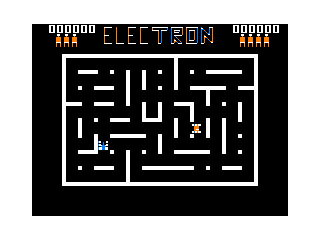 | ElecTron
(1984) | A close clone of the arcade game, although some sequences (notably the Light Cycles) ran a bit slow. |
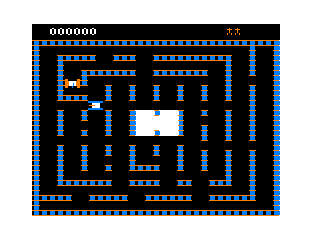 | Kron
(1983) | This earlier version is also a close clone of the arcade game. The speed was closer to the original, although the graphics were not quite as detailed. |
Venture |
Arcade Original: | Title
(Released) | Comments |
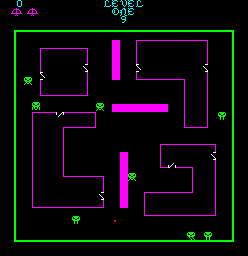 | Venture
(1981) | An early Dungeons and Dragons style game. Your goal is to get treasures, and kill/avoid monsters. There is a main screen showing various rooms that you can go into, and you can enter the rooms to get the treasures. If you take too long in a room, an indestructable monster will appear and come after you (similiar to Berserk). |
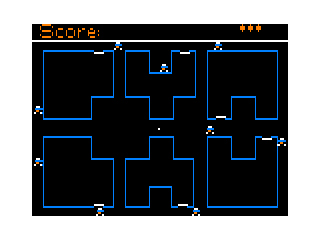 | Montezumas Dungeons
(1984) | A close clone to the original, and suprisingly so since it was one of games thrown onto a subscription tape magazine. Actually features more rooms in the first hall (6 versus the arcade's 4). |
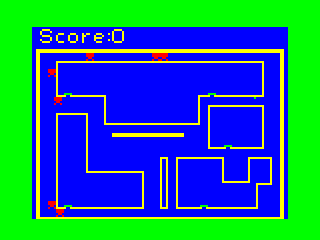 | Venturer
(1982) | A reasonably close clone of the arcade, although with only one hall of rooms, and virtually no sound. Also, instead of an indestructable monster coming after you if you take too long in a treasure room, indestcructable lines come out instead, to both block you from the exit and/or treasure, and to eventually kill you. |
Warlords |
Arcade Original: | Title
(Released) | Comments |
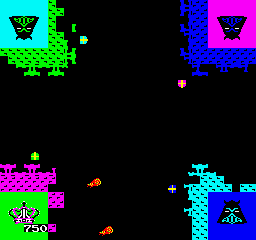 | Warlords
(1980) | Multiplayer game where one tries to break through your opponents castle walls. A clever derivative of the Bustout/Breakout type games that were popular in the 1970's. |
Clones: | Coco Title | Comments |
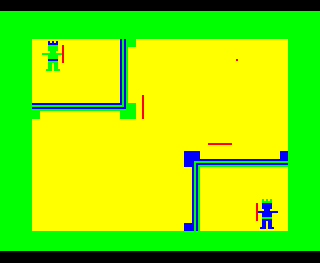 | War Kings
(early 1982) | The earliest version for the Coco that I know of. A 2 player version, with the added twist that your kings inside the castle have a shield which can deflect the ball. |
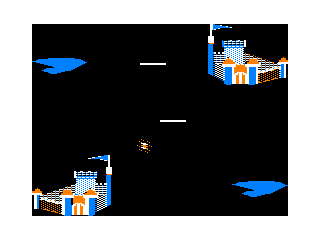 | Castle Guard
(1982) | Another 2 player version, with much better graphics. Castle Guard came out later, and the fireball that you throw around follows a much more unpredictable path. Also, with each hit, your castle sinks into the ground (it doesn't get slowly eaten away like the arcade version or War Kings). |
Xevious |
Arcade Original: | Title
(Released) | Comments |
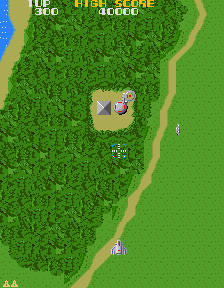 | Xevious
(1982) | Another arcade classic, this game featured smooth scrolling terrain (with various things to bomb) as well as various opponents flying down at you that you have to shoot. There are also spinning 3-dimensional rectangles that you have to dodge as they are indescructable. The arcade game also featured great music and more shades of colors than most other arcade games at the time. |
Clones: | Coco Title | Comments |
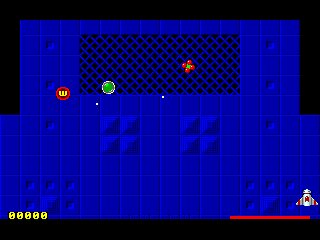 | Cosmic Ambush
(1992) | Nick Marentes originally planned on selling this to Tandy Australia as a 32K Coco 3 cartridge game... but Tandy cancelled the Coco 3 just before it was finished. Nick then released it as Freeware after a friend thought that it was too good to be allowed to disappear. Featuring 16 color smooth hardware scrolling graphics and digitized sound effects, the only major problem with it is the flickering of the sprites. It also didn't feature bombing, but added weapon power-ups instead. |
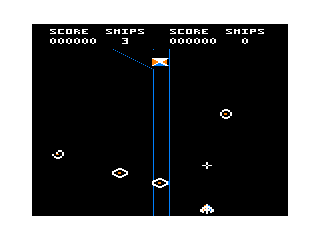 | Devious
(1984) | This Coco 1/2 version featured smooth vertical scrolling as well, although slower than the arcade and only drawing outlines of things like roads, etc. But it plays very similar to the arcade original, including both shooting and bombing, and the bombing crosshairs. |
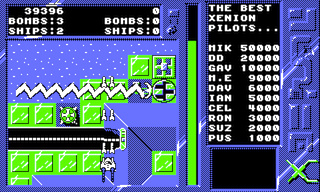 | Xenion
(1988) | This Coco 3 version has entire star systems to fly through, with different themes to each planet, and wider variety of enemies (including power grids, etc.) than even the arcade original. Australia must have had a thing for Xevious; both this version and Cosmic Ambush were programmed by Australians. A bit of trivia is that there apparently was a Coco 1/2 versions of this game as well, but none of us have been able to find it. |
Zaxxon |
Arcade Original: | Title
(Released) | Comments |
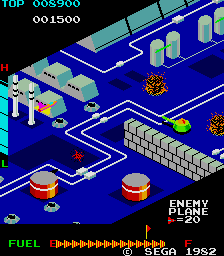 | Zaxxon
(1982) | One of the first isometric 3-D games, Zaxxon was also one of the few officially ported games to the CoCo. Featuring a 3-D look and diagonal scrolling, it was a very popular space shoot-em-up in the early 1980's. |
Clones: | Coco Title | Comments |
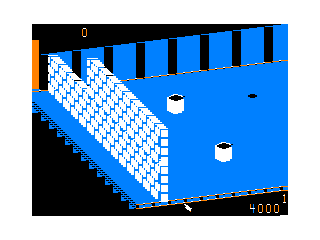 | Zaksund
(early 1983) | This version came out almost at the same time as the official version, which was released Feb. 7, 1983. While the sound was somewhat better than the official version, the graphics were flickery (no double-buffering), and the isometric angle was wrong - an even byte of pixels before it shifted down one row (to make angle calculations easier). |
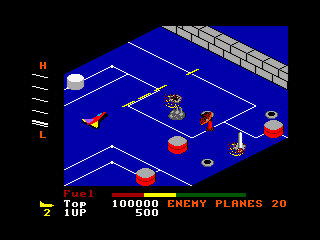 | Z-89
(1989) | Steve Bjork did the original Coco 1/2 port of Zaxxon for Sega in 1982-1983. In 1989, he decided to return to the game that made him famous, and re-did Zaxxon for the Coco 3. Featuring graphics much closer to the original arcade, digitized sound effects, and even adding a new element (meteors) when flying in the space sequence, this version is a big improvement on the original. Licensing issues prevented this from being officially called Zaxxon, although it could be considered the "official" port to the Coco 3. |














































































































































































































